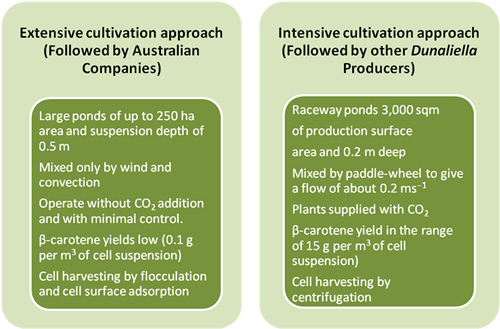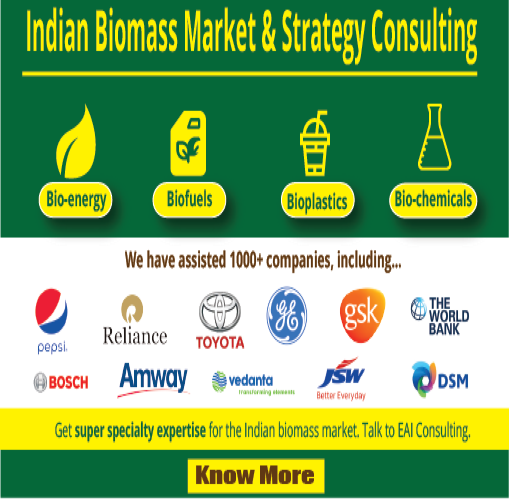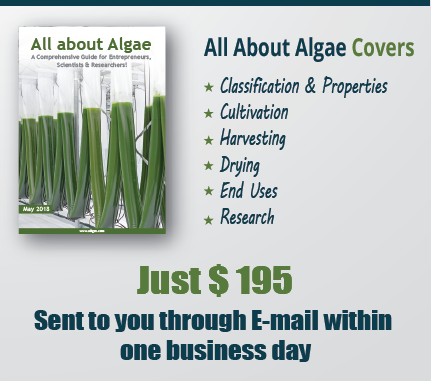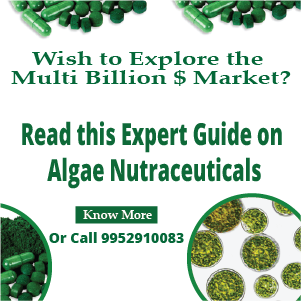Beta Carotene -Highlights
|
Good sources of beta-carotene include dark green and orange-yellow vegetables, such as carrots, sweet potatoes, squash, spinach, broccoli, romaine lettuce, apricots, and green peppers. Dunaliella salina, a marine microalga is a rich source of beta-carotene, alpha-carotene, cryptoxanthin, zeaxanthin, lutein and lycopene. Other algae strains used for beta carotene production include Spirulina platensis, Chlorella Caulerpa taxifolia Beta-carotene was the first carotenoid from algae to be commercialized. The average concentration of carotenoids in most algae is only 0.1–2%, but Dunaliella when grown under the right conditions of high salinity and light intensity will produce up to 14% beta-carotene. Dunaliella production facilities are located in areas where solar irradiance is maximal, cloudiness is minimal, climate is warm, and hypersaline water available. Beta-carotene is the precursor for Vitamin A biosynthesis in the body. Like all other carotenoids, beta-carotene is an antioxidant. It protects the body from damaging molecules called free radicals. Research has proven that consumption of the Dunaliella salina algae is effective in prevention of some forms of cancer. Beta-carotene has the largest share of the market. Valued at $247 million in 2007, this segment is expected to be worth $285 million by 2015, a CAGR of 1.8%. Australia is now the major producer of natural beta-carotene from Dunaliella
|
Beta Carotene
Beta-carotene belongs to the group of pigments called carotenoids. Carotenoids are a class of natural fat-soluble pigments found principally in plants, algae, and photosynthetic bacteria, where they play a critical role in the photosynthetic process. In human beings, carotenoids can serve several important functions. The most widely studied and well-understood nutritional role for carotenoids is their provitamin-A activity. Beta-carotene is converted to Vitamin A in the body.
Until 1980, production of beta-carotene was synthetic. Natural carotenoids, although more expensive than synthetic have the advantage of supplying the natural isomers in their natural ratio and the natural isomers of beta-carotene are considered superior to the trans-synthetic form. In 1994 algal beta-carotene was sold in small quantities.
Sources of Beta-Carotene
Good sources of beta-carotene include dark green and orange-yellow vegetables, such as carrots, sweet potatoes, squash, spinach, broccoli, romaine lettuce, apricots, and green peppers.
Dunaliella salina, a marine microalga is a rich source of beta-carotene, alpha-carotene, cryptoxanthin, zeaxanthin, lutein and lycopene.
The average concentration of carotenoids in most algae is only 0.1–2%, but Dunaliella when grown under the right conditions of high salinity and light intensity will produce up to 14% beta-carotene. Dunaliella is, therefore, well suited to the commercial production of beta-carotene and several industrial production plants are in operation around the world including Australia, Israel, USA, India and China.
Algae Strains for Beta-Carotene Production
Dunaliella (D salina, D bardawil, D kona) |
Spirulina platensis |
Chlorella |
Caulerpa taxifolia |
Commercial Production of Beta-carotene
Business Opportunities & Market Size of Beta Carotene
Read More @ Comprehensive Report on Attractive Algae Product Opportunities.
Dunaliella has the ability to grow at very high salt concentrations where few other organisms can survive. Its high temperature tolerance (up to about 40°C), and the high cell content of beta-carotene (up to 14% of dry wt.) made this alga an attractive candidate for commercial production of beta-carotene. The extreme conditions under which this alga grows means that relatively simple cultivation systems can be used. Dunaliella production facilities are located in areas where solar irradiance is maximal, cloudiness is minimal, climate is warm, and hypersaline water available. Dunaliella for beta-carotene production has been cultivated in large shallow ponds.
These ponds have a depth of between 30 and 60cm and are only mixed by wind and thermal convection. The harvested biomass is extracted and pure beta-carotene or mixed carotenoids are sold as a nutritional supplement and natural food coloring. Dried Dunaliella powder is also sold as a feed additive for aquaculture to pigment crustaceans such as prawns.
http://www.bsb.murdoch.edu.au/groups/beam/BEAM-Appl0.html

Dunaliella cultivation Processes for Beta-carotene Production
Source: http://moritz.botany.ut.ee/~olli/b/DelCampo07.pdf
Beta-carotene Production and Extraction from Dunaliella salina
Business Opportunities & Market Size of Beta Carotene
Read More @ Comprehensive Report on Attractive Algae Product Opportunities.
In comparison to others, Dunaliellahas the following advantages:
a) Disruption of cells is much easier than that in other algae because of its wall-less nature.
b) Continuous culture in laboratory is very easy and the growth rate is relatively high.
c) Resistance to various environmental conditions is higher than in other algae
Optimal Conditions of Beta-carotene Production by Dunaliella salina
Processing Condition | Reactor Configuration | Productivity |
T: 25°C; pH: 7.5 ± 0.5 | Semi-continuous outdoor, closed tubular (55L) | Biomass: 2 g m−2 d−1 Total carotenoids: 102.5 ± 33.1 mg m−2 d−1 (β-carotene: 10% of biomass) |
T: 30°C; pH: 7.5 | Continuous turbidostat, flat-panel (2.5L) | β-Carotene: 13.5 mg L−1 d−1 (15.0 pg cell−1) |
T: 30°C; pH: 7.5 | Continuous turbidostat, flat-panel (1.9L) with in situ extraction | β-Carotene: 0.7 mg L−1 d−1 β-Carotene: 8.3 mg L−1 d−1 (8.9 pg cell−1) |
Benefits and Applications of Beta Carotene:
- Like all other carotenoids, beta-carotene is an antioxidant. It protects the body from damaging molecules called free radicals.
- Beta-carotene is the precursor for Vitamin A biosynthesis in the body.
- Research has proven that consumption of the Dunaliella salina algae is effective in prevention of some forms of cancer.
- Several clinical studies have revealed a correlation between the incidence of cancer and low levels of beta-carotene in the blood.
- Natural beta-carotene prevents the decrease of white blood cells and platelets due to ionic radiation, thus proving to be protective against nuclear radiation.
- Beta-carotene is also in used in malnourished (underfed) women to reduce the chance of death and night blindness during pregnancy, as well as diarrhea and fever after giving birth.
- Beta-carotene is found to be useful in the following cases
- Prevention against cancer and heart disease
- To slow the progression of cataracts
- To prevent macular degeneration
- To boost immunity
- To protect the skin against sunburn
- Asthma
- Depression
- Infertility
- Parkinson’s disease
- Psoriasis
- Arthritis
- High blood pressure
- Cervical dysplasia
- Intermittent claudication
Market Scope
Global production of Dunaliella is estimated at about 1,200 ton per year.
The global market for carotenoids was $766 million in 2007. This is expected to increase to $919 million by 2015, a compound annual growth rate (CAGR) of 2.3%. Beta-carotene has the largest share of the market. Valued at $247 million in 2007, this segment is expected to be worth $285 million by 2015, a CAGR of 1.8%.
Prominent Players in the Beta-Carotene Market
Company | Location |
AquaCarotene | USA |
Cognis Nutrition & Health | Australia |
Cyanotech | Hawaii, USA |
Nikken Sohonsha Corporation | Japan |
Tianjin Lantai Biotechnology | China |
Parry Nutraceuticals | India |
Seambiotic | Israel |
Muradel | Australia |
Research Efforts in Beta-Carotene Production Using Microalgae
- Murdoch University, Australia
Algae & Seagrass Research Group of the School of Biological Sciences and Biotechnology in Murdoch University is actively engaged in the identification of new algae strains for commercial-scale biofuels production, physiology & biochemistry, commercial-scale algae culture systems, downstream processing, techno-economic modeling & analysis, market research. A lot of research on Dunaliella cultivation for beta-carotene production is carried out in the university.
The algae research center has a very large culture collection of both Dunaliella and Haematococcus species as well as other carotenoid-overproducing algae such as Chlorella fusca.
- Wageningen University, The Netherlands
Researchers at the Wageningen University have developed a process of milking carotenoids from Dunaliella.
http://www.algae.wur.nl/UK/projects/Milking+of+carotenoids+from+Dunaliella/
Facts
- Australia is now the major producer of natural beta-carotene from Dunaliella.
- Beta-carotene was the first carotenoid from algae to be commercialized.
- Beta-carotene exists in several different configurations (isomers). Beta- carotene found in fruits and vegetables contains about 10% of cis-isomers and beta-carotene derived from algae contains about 50% of the 9-cis isomer.
- Recent experiments in Israel show that naturally derived beta-carotene (from Dunaliella bardawil algae) is four times more effective in deactivating oxidation products (conjugated dienes) than is synthetic beta-carotene.
Related Links
|
Click Here to Know More |
|
|
Poly unsaturated fatty acids(DHA,ARA,GAL and EPA) Aquaculture Feed (Shrimp feed, Shellfish Feed, Marine Fish Larve cultivation ) |
|
View the complete list
of products from Algae




